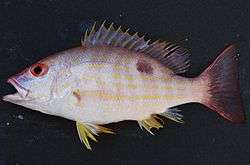Lane snapper
| Lane snapper | |
|---|---|
 | |
| Scientific classification | |
| Kingdom: | Animalia |
| Phylum: | Chordata |
| Class: | Actinopterygii |
| Order: | Perciformes |
| Family: | Lutjanidae |
| Genus: | Lutjanus |
| Species: | L. synagris |
| Binomial name | |
| Lutjanus synagris (Linnaeus, 1758) | |
 | |
| Synonyms | |
| |
The lane snapper (Lutjanus synagris) is a species of snapper native to the western Atlantic Ocean from North Carolina to southern Brazil, including the Gulf of Mexico and the Caribbean Sea. It can be found in a wide range of habitats, though it prefers coral reefs and sandy areas with plentiful vegetation. It occurs at depths from 10 to 400 m (33 to 1,312 ft), most frequently between 21 and 70 m (69 and 230 ft).[2]
This species is silvery-pink to reddish in color, with short, irregular, pink and yellow lines on its sides; it has a diffuse black spot, about as large as the eye; the dorsal fin is centered above the lateral line; the outer margin of the caudal fin is blackish. Similar fish are the mutton snapper, Lutjanus analis, and the mangrove snapper, L. griseus. This species can reach a length of 60 cm (24 in), though most do not exceed 25 cm (9.8 in). The greatest recorded weight for this species is 3.5 kg (7.7 lb).[2]
The lane snapper spawns March through September; it is sexually mature at 6 in (15 cm). It feeds on the bottom, taking crustaceans, mollusks, and smaller fish. Like other species of snappers, it is prized for its tasty, white meat. Lane snapper are more typically caught in shallower (20-60 ft) waters than many other snappers, most commonly yellowtail snapper and mangrove snapper. Larger specimens can be found in somewhat deeper waters, but are typically less plentiful.
Lane snapper are generally caught on hook and line, and are considered to be more aggressive and easier to catch than other snappers, as they tend to be less wary of hooks and lines. They are easily caught on a variety of live and frozen baits, such as shrimp, squid, cut bait, and minnows; artificial lures and baits have also been known to be effective. Generally, lane snapper are not specifically targeted by anglers, but many are caught as a bycatch by anglers fishing for grouper or other species of snapper, as well as other shallow to mid-depth bottom fish.
References
| Wikimedia Commons has media related to Lutjanus synagris. |
- ↑ Lindeman, K., Anderson, W., Carpenter, K.E., Claro, R., Cowan, J., Padovani-Ferreira, B., Rocha, L.A., Sedberry, G. & Zapp-Sluis, M. (2016). Lutjanus synagris. The IUCN Red List of Threatened Species doi:10.2305/IUCN.UK.2016-1.RLTS.T194344A2317059.en
- 1 2 Froese, Rainer and Pauly, Daniel, eds. (2013). "Lutjanus synagris" in FishBase. December 2013 version.
